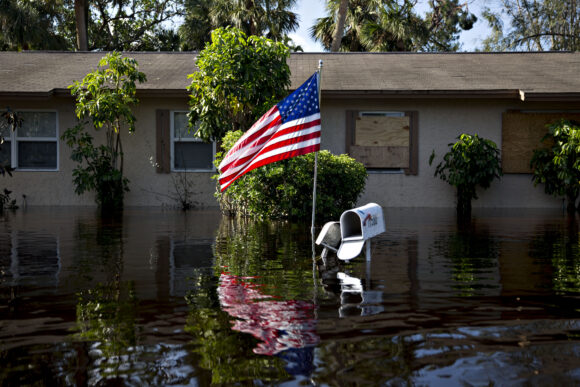As the US government shutdown hurtles through a fourth week, the main source of federal funding for disaster relief efforts is running critically low, according to people familiar with the matter and an internal report reviewed by Bloomberg.
The Disaster Relief Fund, which finances federal assistance to disaster survivors and the deployment of federal staff to disaster zones, has reached a precarious level, current and former Federal Emergency Management Agency staff warn, threatening to curb crucial government disaster relief assistance in the middle of hurricane season.
Last October, FEMA officials began ringing alarm bells when the relief fund balance dipped to $11 billion. The agency was stretched thin at the time responding to hurricanes Helene and Milton, which struck the US within days of each other.
The current funding level is now more than a billion dollars below that.
A report of the Disaster Relief Fund spending level through the end of September showed the agency with about $8.4 billion remaining for staff deployment, aid and other efforts tied to presidential major disaster declarations, alongside $1.1 billion to respond to unexpected future events, such as earthquakes.
The agency is attempting to manage the remaining funds to ensure there are enough should a natural disaster occur. But the agency would likely need to prioritize immediate response efforts while postponing longer-term recovery efforts, according to one of the people.
If this funding completely dries up, the situation could become even more dire, with calls to FEMA’s help line going unanswered. Staffing shortages could also hinder disaster survivors from registering for assistance.
“All recovery operations will be on hold,” said Michael Coen, who served as FEMA chief of staff under President Joe Biden and signed an open letter in August criticizing the Trump administration’s cuts to federal disaster work.
There’s little indication that the shutdown will soon end, with both sides locked in a standoff over expiring health-care subsidies. The funding lapse is now the second longest on record, and may stretch into November. President Donald Trump is due to head for meetings in Asia at the end of the week, and no talks are scheduled before then.
While a House-passed stopgap spending bill under consideration in the Senate would replenish funding to the agency, Democrats have insisted on health-care funding to prevent Obamacare premiums from spiking in the new year.
Civilian federal workers are set to miss their first full paycheck on Friday.
The dwindling of the Disaster Relief Fund comes as the government’s National Flood Insurance Program authorization expired on Sept. 30 and hasn’t been reauthorized by Congress, meaning the program can’t issue any new policies or renew existing policies. The National Association of Realtors has estimated the lapse in authorization for the National Flood Insurance Program could impact more than 1,300 property sales each day.
Related: National Flood Insurance Program Expires | NAMIC to Federal Lawmakers: Do Your Job on Flood Insurance Program
Trump floated the possibility of eliminating FEMA early in his presidency. He then established a review council to make recommendations on the agency’s future before the year’s end. But that hasn’t stopped the administration from pushing forward with cuts to grant funding, staffing and programming.
In the first six months of the year, roughly 2,400 people left the agency, including many long-time senior staff, due to firings, resignations, and early exit packages, according to a government watchdog report.
Photo: A US flag flies outside a flooded home in Bonita Springs, Florida. Photographer: Daniel Acker/Bloomberg
Was this article valuable?
Here are more articles you may enjoy.



 North Carolina Sting Operation Alleges Roofer Damaged Shingles to File Claim
North Carolina Sting Operation Alleges Roofer Damaged Shingles to File Claim  ‘Door Knocker’ Roofers Were Everywhere. NC Farm Bureau Saw an Opportunity
‘Door Knocker’ Roofers Were Everywhere. NC Farm Bureau Saw an Opportunity  UPS Ripped Off Seasonal Workers With Unfair Pay Practices, Lawsuit Alleges
UPS Ripped Off Seasonal Workers With Unfair Pay Practices, Lawsuit Alleges  Viewpoint: Artificial Intelligence Is Rewriting the Rules for Commercial Lines
Viewpoint: Artificial Intelligence Is Rewriting the Rules for Commercial Lines 

